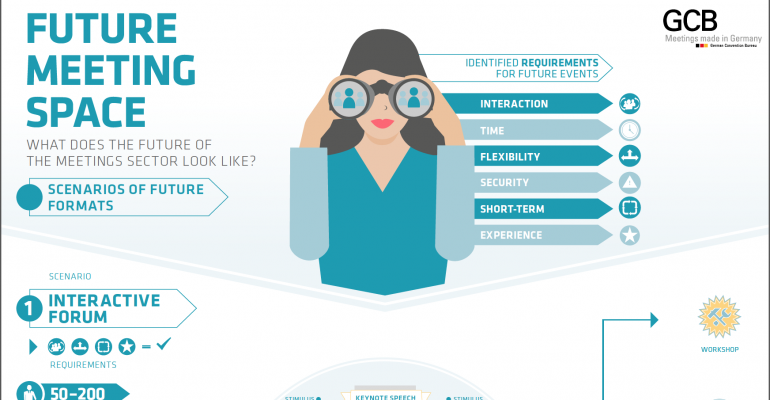The German Convention Bureau's Future Meeting Space research project is looking at all the different needs meetings have to fulfill these days, from a totally unplugged retreat-type getaway for deep thinking to its exact opposite, and four more in between. The GCB released this infographic to help illustrate what's involved in each of the six scenarios explored in the Future Space project, which the GCB is doing in partnership with the European Association of Event Centres and Fraunhofer Institute of Industrial Engineering.
Here's a little more verbiage to help clarify some of the scenarios outlined in the infographic, which while great, can be a little confusing to decode:
1. Unplugged Conference. These are what I would call more of a retreat type of meeting, where you go somewhere remote with a small (50 or fewer participants) group and hopefully pry them away from their devices long enough to do some deep-dive thinking and collaboration.
2. Co-Working Conference. This one is the unplugged's opposite, where the timeframe is stretched out over a longer period and the agenda is interspersed with time (and dedicated spaces) to attend to back-at-the-office issues. According to the GCB, this gives participants more time to network and share knowledge more informally.
3. Virtual-to-Physical Conference. Anyone who's done a meetup at an industry event with a subgroup of Twitter, listserv, or other virtual community members would find this scenario familiar. Those who have only known each other via avatar can come together in real life, forge deeper ties, and go back to their virtual worlds after the event with richer relationships.
4. Interactive Forum. This one sounds more like a traditional (good) small conference, where up 200 gather together for a plenary, then split up into small groups to build on the topics outlined in the plenary, perhaps using World Café and/or gamification elements to drive deeper participation. Later everyone regroups to share results and challenges, and lay out the next steps.
5. Satellite Conference. "In this instance a main meeting is held across several venues simultaneously—with about 50 people per venue—keeping face-to-face connections but losing long distance travel," according to the GCB. The various venues are connected via live video and a common agenda, but each subgroup can also work on how the topics play out in their specific region. The best part? Using holograms and robots to share knowledge across venues!
6. Hybrid Conference. I hope most planners have been able to check out this option, which entails an online component to an in-person event. This format saves time and costs for those who attend via Internet, and everyone can still stay on the same page, learning-wise. The best ones I've participated in digitally also provide a separate facilitator for the online audience to ensure their participation is incorporated into the IRL event and to build community among digital participants.
I think GCB is right on target with these scenarios being good ways to meet the needs of future meeting goals and objectives.
Are there others you see that are missing here that you believe will be an essential piece of the meetings mix moving forward? One omission that jumps out at me is the trade show component—what will the buyer/seller interaction scenario of the future look like? In the meantime, here's the infographic!






